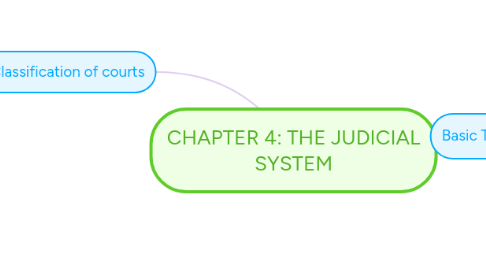
1. Classification of courts
1.1. subordinate courts / lower courts
1.1.1. magistrates court
1.1.1.1. composition: 1 member per sitting
1.1.1.2. original jurisdiction
1.1.1.2.1. civil matters: hear a civil case not exceed RM100,000
1.1.1.2.2. CRIMINAL MATTERS: try criminal offences
1.1.2. session court
1.1.2.1. composition: 1 judges
1.1.2.2. original jurisdiction:
1.1.2.2.1. civil matters: hear civil case not exceed RM,000,000
1.1.2.2.2. criminal matters: all criminal offences, EXCEPT punishable to death
1.1.2.3. supervisory jurisdiction
1.1.2.3.1. limited supervisory role over the Magistrate's court
1.2. superior courts / higher courts
1.2.1. federal court
1.2.1.1. composition: 3 judges per sitting.
1.2.1.2. original jurisdiction
1.2.1.2.1. civil and criminal matters
1.2.1.3. appellate jurisdiction
1.2.1.3.1. civil and criminal matters
1.2.1.4. referral jurisdiction
1.2.1.5. advisory jurisdiction
1.2.2. court of appeal
1.2.2.1. composition: 3 judges (or greater uneven number)
1.2.2.2. appellate jurisdiction
1.2.2.2.1. civil matters
1.2.2.2.2. criminal matters
1.2.3. high court
1.2.3.1. Composition: 1 judge persitting
1.2.3.2. original jurisdiction
1.2.3.2.1. civil matters: unlimited jurisdiction. They hear civil matters exceeding RM1,000,000
1.2.3.2.2. criminal matters
1.2.3.3. appellate jurisdiction
1.2.3.3.1. civil matters
1.2.3.3.2. criminal matters
1.2.3.4. revisionary jurisdiction
1.2.3.5. supervisory jurisdiction
1.3. court with special jurisdiction
1.3.1. court for children
1.3.1.1. composition
1.3.1.1.1. first class magistrate, by 2 advisors (one of the advisor must be a woman)
1.3.1.1.2. advisors' function
1.3.1.2. jurisdiction
1.3.1.2.1. all ofences punishable, EXCEPT offences punishable with death penalty.
1.3.1.2.2. the case for offences punishable with death penalty will be heard before the High Court
1.3.1.3. sentencing
1.3.1.3.1. admonish and discharge
1.3.1.3.2. probation order: the child will be placed under the supervision of a probation officer
1.3.1.3.3. Henry Gurney School: if the offence committed is very serious, the child will be sent to this school for a period of 3 years or until they reaches the age of 21
1.3.1.4. proceeding
1.3.1.4.1. hearing is limited to members and officers of the court
1.3.2. special court for rulers
1.3.2.1. compostion
1.3.2.1.1. chief justice of federal court (+) chief judge of high court of Malaya (+) chief judge of high court Sabah Sarawak (+) 2 other judges (either FC or High Court)
1.3.2.2. jurisdiction
1.3.2.2.1. to hear and try civil and criminal against Yang di-pertuan Agong and Ruler in their personal capacity
1.3.3. court-martial
1.3.3.1. composition
1.3.3.1.1. to hear Cases: chief officer of Armed Forces staff, Chief of the Army, Chief of the Navy, Chief of the Airforce
1.3.3.2. jurisdiction
1.3.3.2.1. covers the armed forces (Army, Navy and Air Force) and it has the jurisdiction to try any person subject to service law for offences triable
1.3.3.3. offences
1.3.3.3.1. aiding the enemy
1.3.3.3.2. communication with the enemy
1.3.3.3.3. offences against morale
1.3.3.3.4. looting (during war,stealing goods)
1.3.3.3.5. mutiny and subordination
1.3.3.3.6. avoidance or failure to perform military duties
1.3.3.4. sentencing
1.3.3.4.1. include death, imprisonment, dismissal with disagrace, forfeiture of seniority of rank, fine or reprimand.
1.3.4. native courts
1.3.4.1. native court of appeal (highest)
1.3.4.2. district native court
1.3.4.3. native court (lowest)
1.3.5. syariah court
1.3.5.1. syariah subordinate court (lowest)
1.3.5.2. syariah high court
1.3.5.3. syariah appeal court (highest)
1.3.6. industrial court
1.3.6.1. composition
1.3.6.1.1. 1 chairman + 2 panels (one representing employers, one for employees)
1.3.6.2. jurisdiction
1.3.6.2.1. is a creature of state the Industrial Relations Act 1967
1.3.6.2.2. most cases relate to the dismissal of employees (unfair dismissal)
2. By the way, this is a floating topic. To create a floating topic, simply drag it away from the map center.
3. Basic Terminologies
3.1. judiciary:
3.2. a branch of government which is concerned with law and the legal system.
3.3. court
3.3.1. an institution that is established by the government to administer justice, and that serves as formal platform to settle disputes between individuals or individuals&states.
3.4. jurisdiction
3.4.1. the rights of courts to hear and decide certain cases
3.5. original jurisdiction
3.5.1. the right of courts to hear and decide a case for the first time
3.6. appellate jurisdiction
3.6.1. the power to courts to consider a case after it has been decided by the lower courts.
3.7. supervisory jurisdiction
3.7.1. the power of high court to control activities of subordinate courts of tribunals
3.8. civil case
3.8.1. a case between individual (company or firm) with another individual (or entity). For eg: a case of breach of contract between Salman (an individual) with Munah (an individual)
3.9. criminal case
3.9.1. a case that involves action that is considered as harmful to the society. For eg: murder, drug, trafficking, robbery.
